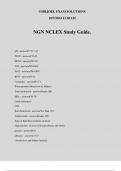©SIRJOEL EXAM SOLUTIONS
10/7/2024 11:03AM
NGN NCLEX Study Guide.
pH - answer✔7.35-7.45
PCO2 - answer✔35-45
HCO3 - answer✔22-26
PO2 - answer✔80-100%
SaO2 - answer✔96-100%
BUN - answer✔8-25
Creatinine - answer✔0.5-1
Waste product filtered out by kidneys
Total cholesterol - answer✔under 200
HDL - answer✔30-70
Good cholesterol
LDL
Bad cholesterol - answer✔less than 130
Triglycerides - answer✔under 200
Type of lipid that circulates in blood
High amount- increase risk heart disease and stroke
protein - answer✔6-8
albumin - answer✔3.5-5
-checks liver and kidney function
, ©SIRJOEL EXAM SOLUTIONS
10/7/2024 11:03AM
- high=dehydration, diarrhea
-low=kidney/liver disease, infection, inflammation
amylase - answer✔25-151
Enzyme helps digest carbs
lipase - answer✔10-140
Enzyme made in pancreas that break down fats
High- problem w prancers
ammonia - answer✔10-80
Toxic waste product made during protein digestion
High- liver disease, kidney failure, genetic disorder, Reyes
ALT/AST - answer✔10-40
Bilirubin - answer✔total less then 1.5
glucose - answer✔70-100
A1C - answer✔under 6%
Average blood sugar over 3 months
hemoglobin - answer✔woman 12-15, male 14-16
hematocrit - answer✔female 35-45% male 40-50%
platelets - answer✔150,000-400,000
aPTT - answer✔20-30 seconds
PT - answer✔9-11 seconds
INR - answer✔1 (with warfarin 2-3)
K - answer✔3.5-5.0: intracellular, neuromuscular/muscular contraction, regulated by kidney.
o Foods: avocado, potatoes, spinach, strawberries, tomatoes, raisins
o NEVER GIVEN IV PUSH, IM, SUBQ, max infusion 10 mEq/hr, K can cause phlebitis=assess
IV site frequently, assess renal function before administering, monitor I&O
, ©SIRJOEL EXAM SOLUTIONS
10/7/2024 11:03AM
o High/low=impacted heart rhythm, and muscle function w/ leg cramping
o High d/t: K retaining diuretics, CRF, Addison's, tissue damage- if CRF=Kayexalate, IV
glucose with insulin, Ca, dialysis, avoid salt substitutes
o Low d/t diuretics/corticosteroids, vomiting, diarrhea, NG suction, CRF, -no supplements on
empty stomach
o Hypo=st depression Hyper=Tall T waves
Na - answer✔135-145: extracellular, regulates cell size and osmosis, maintains water balance,
nerve impulses, muscle contraction, BP, blood volume, regulates acid-base balance, regulated by
salt intake, aldosterone, urinary output
o Hyponatremia: d/t burns, diarrhea, HF, diuretics, vomiting, diaphoresis, CRF, SIADH, ^BS
*Lithium Tox!
• S/s: mental confusion, seizures, hallucinations, brain herniation, death
o Hypernatremia: HTN, edema, Cushing's, CRF, hyperaldosteronism, hormones, NSAIDS
• s/s: lethargic, excitability, hypovolemia, pulm edema, muscle twitches, coma, dry flushed skin
Chloride - answer✔96-106: helps balance Na, extracellular fluid
WBC - answer✔5,000-10,oo0
60% Neutrophil: bacteria/fungus
40% Lymphocyte: virus/tumor
8% Monocyte: nonspecific
3% Eosinophil: allergies
0% Basophil: allergies
Troponin - answer✔lower then 0.1
BNP - answer✔under 100 (+100=HF)
Mg - answer✔1.5-2.5: ½ in bone, muscle and nerve function, heart rhythm
o Hypermg: d/t CRF, antacids, Addisons, DM- give calcium gluconate
• s/s: lethargy, n/v, slurred speech, weakness, decreased DTR, slowed cardiac conduction
o Hypomg: d/t malnutrition, pre-e, ETOH, DKA, Crohn's, hyperglycemia, sepsis
, ©SIRJOEL EXAM SOLUTIONS
10/7/2024 11:03AM
• s/s: tingling, twitching, tetany, delirium, convulsions, + Chvostek/Trousseau, hyperreflexia
Phosphorus - answer✔2.8-4.5: cell metabolism, combines w/ Ca in bone, balanced by
parathyroid gland. Ca~P (as one ^/other drops)
Calcium - answer✔9-11: cardiac contraction, bones, nerves, muscles, clotting
o Hypercalcemia: d/t hyperparathyroidism, cancer, Paget's of bone, prolonged immobilization.
s/s: weakness, paralysis, decreased DTR. Monitor for kidney stones
o Hypocalcemia: d/t rickets, vit D deficiency, renal failure, pancreatitis, chelation therapy,
hypoparathyroidism.
• s/s: CATS: convulsions-arrhythmias-tetany-spasms/stridor, +Chvostek sign (cheek) Trousseau
(BP arm)
• when administering IV, warm solution to body temp
Respiratory alKaLOsis s/s: - answer✔lethargy
lightheadedness
confusion
tachycardia
dysrhythmias related to hypokalemia
nausea
vomiting
epigastric pain
numbness and tingling of the extremities
hyperventilation (tachypnea)
Normal plasma osmolality - answer✔270-300
DO-ABLE mnemonic for heart failure interventions - answer✔*Diuretics*- to relieve pulmonary
congestion, fluid overload & return to baseline weight
*Oxygen*- to correct hypoxia
*ACE inhibitors*- to reduce preload and afterload, counteracting compensatory hormones
*Beta-blockers*- to prevent arrhythmias and reduce heart workload




